Home
A comprehensive resource for safe and responsible laser use
New Zealand: NZ restricts handheld lasers over 1 milliwatt
The regulations were based in part on public submissions made in response to a November 2012 Ministry of Health proposal. Submissions were received from organisations including retailers, government agencies, non-government organisations, professional associations, importers, the aviation industry, members of the public and other organisations with an interest in high-power laser pointers. Their suggestions were compiled in a 20-page document which helped guide the new regulations.
"High-power laser pointers can cause eye injuries, even blindness, and skin burns. ACC accepts around 10 claims a year for these injuries," says Mrs Goodhew.
"They can also cause temporary flash blindness, which poses a serious risk if the person affected is a pilot or in charge of a vehicle or equipment. The Civil Aviation Authority reports around 100 laser strike incidents on planes each year.”
The new controls, under Health and Customs legislation, cover the import, supply and acquisition of high-power laser pointers. They do not currently restrict the possession of high-power laser pointers. A bill is before Parliament which, if passed, would make it illegal to be in a public place with a laser pointer without a reasonable excuse.”
"The new controls have been crafted to only target the high risk hand-held laser pointers with a power output of greater than 1 milliwatt,” Goodhew said. “The regulations are in line with Australia’s restrictions and recommendations by the World Health Organization.”
Click to read more...
Canada: Regina has 12 laser pointer incidents thus far in 2013
This compares with five laser incidents during 2012, and one during 2011.
The officials reminded the public that lasing an aircraft is illegal.
From CTV News and OHS Canada
Sweden: Detailed study released of worldwide laser pointer eye injuries
“The purpose of this study was to investigate what dose of laser radiation, in terms of intensity and exposure time, may be associated with eye damages. The study has been limited to unwanted exposures of laser radiation from commercially available laser pointers. Of particular interest has been to search for data that clarify the dose-response relationships for functional disabilities that persist more than 6 months.”
“The study shows that long-term vision loss can occur as a result of involuntary exposure from commercially available (strong) laser pointers at close range. The injury may occur before a normal person is able to respond by closing the eyelid, although there are only a few cases reported. A minor such damage is transient within a few days. It is also likely that such a visible injury to the retina becomes functional, i.e. prevents reading skills. What dosage is required for the disability to become permanent is not clear in the literature. Also, the dynamics of evolvement and repair of tissue damages and disabilities are hardly described at all.”
Author: Stefan Löfgren, Jörgen Thaung and Cesar Lopes
Publisher: Strål Säkerhets Myndigheten (SSM - Swedish Radiation Safety Authority)
Language: English
Publication date: 19 November 2013
No of pages: 50
Price per publication: 100 SEK (incl. VAT)
Download: 2013:30 Laser pointers and Eye injuries - An analysis of reported cases [1385 kb]
A summary by LaserPointerSafety.com of the study’s objectives, major findings, and conclusion is here.
UPDATED January 2016: The SSM released an update, with 47 additional cases worldwide of eye injuries from consumer lasers. A summary by LaserPointerSafety.com is here; the full SSM document is here.
US: Tucson police pilot says he has permanent retinal damage from laser exposure
The statement came as hundreds of Arizona law enforcement pilots attended a safety seminar in Tucson focusing on laser beam incidents. In 2012 in Tucson alone, the police department’s air unit had “close to 50 incidents”, according to Potter. As of November 2013, Phoenix was the top U.S. city for laser incidents.
From KVOA News
US: FBI uses sophisticated surveillance to catch Portland man who lased ~25 aircraft
The operation was initiated in August 2013, after multiple incidents of lasers being aimed at aircraft around Portland International Airport. Four law enforcement aircraft were equipped with video surveillance cameras.
On August 10, five aircraft were targeted by a ground-based green laser. One was an Alaska Airlines flight; two were from the FBI and two were from the Portland Police Bureau. At the same time, a surveillance team was on the ground. Using information from the FBI/PBB aircraft sightings, the ground officers observed suspicious behavior from a male in the back yard of a duplex apartment. He was looking up at the sky. He removed something mounted from a stand or pole, and went inside. The laser strikes ceased afterwards.
Six days later, after reviewing the video, consulting Google Earth and Google Maps, and visiting the apartment complex, an FBI Special Agent determined that Apartment 35 -- the one previously surveilled -- was the most likely source of the laser. The apartment was occupied by 39-year-old Stephen Francis Bukucs.
Surveillance cameras were then secretly installed, watching Apartment 35. They could see in daylight, low light and nighttime (using infrared).
Click to read more...
US: Latest FAA statistics show 3,188 incidents, Jan 1 to Oct 17 2013
The 2013 figure of 3,188 laser/aircraft incidents is 16.7% higher than the same period in 2012. If incidents continue at the same pace, there will be 4,063 incidents in calendar year 2013.
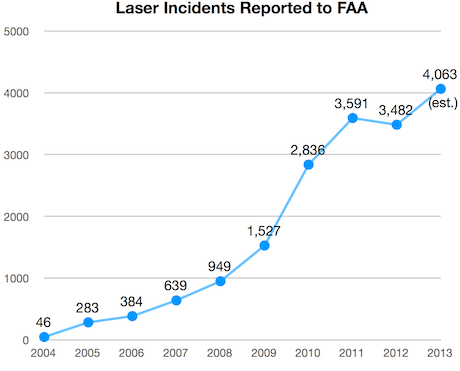
Total Incidents, 2004 to Date
There have been approximately 16,936 laser/aircraft incidents reported to FAA, from January 1 2004 through October 17 2013.For additional details on previous years, see the year-end statistics for 2012, 2011 and 2010.
Commentary from LaserPointerSafety.com
This 16.7% increase represents a setback from the 2012 totals, which were 3% lower than in 2011. Having a rise in 2013 incidents seems to indicate that the publicity and prosecutions which form the majority of current U.S. anti-laser efforts are not having the desired effect.
There has been some speculation that the 2013 figures differ from 2012 in part because FAA may have updated its incident reporting procedures. While FAA is working to include military and overseas incidents, this has not yet been done. In this respect the 2013 figures are directly comparable to earlier years.
Another possible explanation is that pilots have become more aware of the issue and are thus more likely to report a laser sighting. However, pilot information has been widely available since 2008 and has increased as this became of more concern. By now, most pilots should be alerted to the issue and FAA’s reporting requirements. There has not been a major push during 2013 in this area, so increased pilot reporting is probably not a major factor in causing 2013 reports to increase over 2012.
US: New Jersey governor vetos bill to ban laser pointer sales
In his veto message, Christie noted that the New Jersey bill would have gone “well beyond” the federal government’s 5 milliwatt limit for laser pointers. He said there was no criminal use of lasers between 1 and 5 mW in New Jersey. Christie indicated the bill was “arbitrary” and interfered with lawful commerce of pointers typically used in business presentations. (See full text below, after the “Read More…” link.)
The bill was first submitted in November 2010, in response to ongoing problems in Ocean City, N.J. and other beach resort towns where widespread laser pointer sales in boardwalk shops were leading to harassment incidents and aircraft illuminations. The bill, A3169/S418, passed the state Senate on August 19 2013 by a vote of 36-1. It had previously passed the General Assembly on June 24 2013 by a vote of 70-7, with one abstention.
Click to read more...
US: Underwriters Labs offers third-party testing for laser pointer sellers
These regulations, 21 CFR 1040.10 and 1040.11, require laser product manufacturers only to self-certify to the Food and Drug Administration that their products meet safety standards. Once the FDA’s Center for Devices and Radiological Health reviews and acknowledges the certification, the laser product can be marketed in the United States.
UL is providing a third-party, independent check on the manufacturer’s claims. This can be provided to retailers such as Amazon.com which in August 2013 began requiring third-party verification of lasers sold on its website. UL can also assist with preparation of a manufacturer’s FDA report.
Click to read more...
World: Smartphone app can remotely control handheld laser
The company’s free “Evo” app is available on Apple iOS and Android app stores. A smartphone connects to the Evo laser either using a cable from the audio output jack, or wirelessly using an optional $40 Bluetooth module that attaches to the laser. Once connected, the app allows remote control of the laser’s output power, and of its flashing frequency. (Although anyone can download the app, the software does not appear to run unless connected to a Wicked E4 series laser such as the Evo.)
The software code is available as open source, so that hobbyists can create their own software to custom-control the Evo.
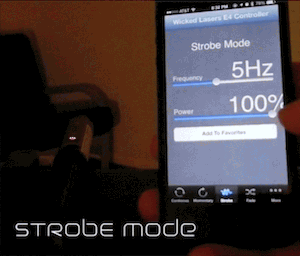
Operating modes include Continuous, Momentary, Strobe, Fade, Morse Code and Ambient (microphone audio level). Click for a YouTube video showing these modes in action.
US: Time-lapse video shows astronomy lasers being used at Mauna Kea
Sean Goebel, a graduate student in astrophysics, has produced a 3-minute time-lapse video showing observatories at Mauna Kea, Hawaii, shooting lasers into the night sky. By analyzing how the beam is distorted by the atmosphere, a telescope’s mirror can be counter-distorted in order to obtain sharper images for astronomers.
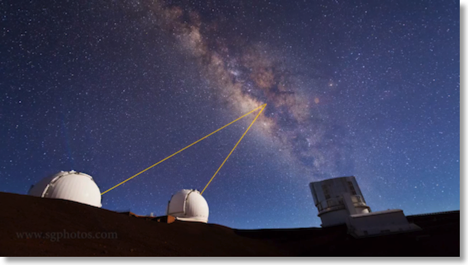
A still frame from the video. Two telescopes are simultaneously observing the same spot in the Milky Way, using lasers to help give a sharper image.
Goebel writes about the lasers:
“A typical laser pointer that you might use to point at stuff/exercise your cat is about 5 mW. That's five one-thousandths of a watt. Not a whole lot of power. And yet it's enough to blind airplane pilots. The lasers on the telescopes are in the range of 15-40 watts. The FAA calls a no-fly zone over the area when a laser is in use, and two people have to stand around outside in the freezing temperatures and watch for airplanes. Each of them has a kill switch to turn off the laser in case an airplane comes near.”
“Additionally, the telescope has to send its target list to Space Command ahead of time. Space Command then tells them not to use the laser at specific times, ostensibly to avoid blinding spy satellites. However, you could calculate the spy satellite orbits if you knew where they were at specific times, so Space Command also tells the telescope to not use the laser at random times when no satellites are overhead.”
To clarify, the FAA does not have a no-fly zone, but instead issues a “Notice to Airmen” or NOTAM about the laser operations. It is not illegal to fly over the area. Fortunately, at Mauna Kea’s location and altitude only a couple of flights per month fly at night within the laser-affected airspace over the mountain. At one telescope, planes get close enough to the beam to cause a shutoff once every year or twin.
Automated aircraft-detection systems are slowly being tested and phased in, since the cost of having humans watch the skies all night at Mauna Kea’s altitude (13,700 feet) is about $600,000 per year.
The video, “Mauna Kea Heavens”, can be seen at Sean Goebel’s website, which also has more information about adaptive optics lasers and how the video was made. Additional information on aircraft frequency and spotting techniques is courtesy Paul Stomski of the Keck Observatory. A story about Keck’s aircraft protection system appears online in Ascend magazine.
UK: Pilots want stronger laws, jail, for laser attacks
The Association says the lasers are too easily available, and that although it is illegal to aim a laser at an aircraft, the punishments have been too lenient: “Slaps on wrists and £150 fines are not enough.”
According to a September 29 2013 article in the Sunday Express, there were 1,570 laser incidents reported to the Civil Aviation Authority in 2012, and 1,911 in 2011. The most prominent airports cited were Birmingham, Manchester, Liverpool, the East Midlands, Bristol, Heathrow and Gatwick.
From the Sunday Express
US: Toy helicopter powered by 500-watt laser beam; kept aloft for more than a day
They noted that the technique could be scaled up to create laser-powered drones that could do useful work: “commercial laser-powered flight applications are only a few years away.”
Click to read more...
UK: Handheld (industrial) laser easily cuts through metal
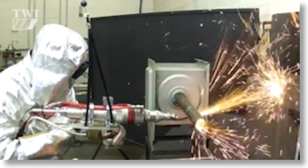
The device came to public attention September 28 2013 when gadget blog Gizmodo published an article entitled Holy Crap, This Real-Life Laser Rifle Cuts Through Metal Like Nothing. The article links to TWI’s YouTube video of the laser in action.
New Zealand: Bill to make handheld laser possession in public illegal, passes first reading
The bill was originally introduced November 15 2012. The sponsor, National MP Dr Cam Calder, said the handheld laser pointers “have the potential to cause considerable harm, and put lives at risk when improperly used.” In addition to a penalty of up to three months in prison and up to a NZD $2000 fine (USD $1650), police also would be able to confiscate lasers.
Dr Calder told Parliament that the New Zealand Airline Pilots Association was “very much” in favor of the bill. In 2012, there were over 100 incidents where lasers were aimed at aircraft and moving vehicles.
According to NZ News, “Labor and the Greens supported the bill, although they had concerns the definitions in the bill might be too broad.” Below is the debate on the bill (after the “Read More…” link.) The bill was referred to the Transport and Industrial Relations Committee; their report is due on or before March 25 2014.
In addition, the Ministry of Health is developing regulations addressing the importation and sale of handheld lasers. They are expected to be announced by the end of 2013.
Click to read more...
US: FAA prosecutes 1.5% of all laser/aircraft incidents
This appears to describe civil cases brought by FAA based on violations of 14 CFR 91.11, which states “No person may assault, threaten, intimidate, or interfere with a crewmember in the performance of the crewmember's duties aboard an aircraft being operated.” The maximum penalty is an $11,000 fine. FAA announced on June 1 2011 its intent to charge laser perpetrators under this law, so the 129 cases referenced above would be since that time.
During the same time period, from June 2011 to September 2013, there were 8,507 reported laser/aircraft incidents in the U.S. This means that 1 out of every 70 reported incidents results in a civil prosecution. Stated another way, 1.5% of all laser/aircraft incidents result in a civil prosecution.
Click to read more...
Germany: 261 laser/aircraft incidents in 2012
This information was given by a spokesperson for Berlin Tegel airport, speaking after a September 8 2013 incident where a 14-year-old boy aimed a laser at three airplanes landing at the airport.
From BZ-Berlin (original German text and Google-translated English text)
US: Laser aimed from aircraft to ground results in dozens of calls
In a September 16 2013 article, HawaiiNewsNow said there were “dozens” of inquiries about the nighttime green light. One person emailed that the aircraft circled his area about six times at 1:00 am, with a wide green laser that appeared to be scanning downward. Another email confirmed the multiple passes with a V-shaped green laser.
The Army Corps of Engineers is conducting the work. They stated that the laser is not harmful to the eyes. The Oahu work should take about a week, and mapping the entire state should conclude in November.
From HawaiiNewsNow. Similar flyovers using visible green lasers have occurred in other U.S. cities, such as New York City in 2010 and 2012, according to a a brief Google search of such reports, for example here and the comments here.
UK: "Blaze" bike light uses laser to caution motorists during night rides
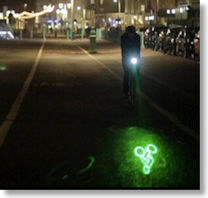
The laser-projected image appears to be formed by a holographic diffraction grating, similar to those used in “caps” on laser pointers to make simple logos such as faces, dollar signs and other graphics:

Blaze’s inventor, Emily Brooke, put the product on Kickstarter in November 2013 and reached its funding goal within 27 days. The initial cost of a Blaze is £60 (USD $96).
A description at Kickstarter states that when Blaze is off of its bracket on the bicycle, the laser cannot be turned on, as a safety measure. The internal laser will be a “more powerful module than you’d typically find in a laser pointer”. However, because the beam is spread out by the optical element, it will be a Class 2 laser product with human access safety equivalent to a laser pointer that is less than 1 milliwatt.
She also notes that the laser is aimed down onto the road so it will not dazzle drivers.
From CNN
UPDATED -- October 27 2014: Blaze is out of Kickstarter and is a product. The new website is at Blaze.cc. According to the website, as of October 2014 the company has sold 3,000 Blaze laser bike lights. The final cost is $200, shipped anywhere worldwide. The laser is a direct-diode green laser, not a DPSS. It is said to be “retina safe.”
Canada: Laser strikes up significantly in Edmonton
A police pilot spokesperson said laser users are not reading the packaging which clearly states not to aim at aircraft. After being caught, "There's been a lot of apologies, a lot of regret, some people not realizing the consequences of what they were doing, and then there's been the far opposite -- I can't believe this is happening, this is ludicrous, this isn't serious, it's just a laser pointer."
The pilot also said that a ban is not the answer: "If it's used properly, it's harmless. It's hard to ban something like that, the sale of it completely if 95% of the general public are using it properly."
He noted that not just police aircraft are being lased. Commercial and private aircraft also are at risk.
Edmonton police helicopter pilots are equipped with safety glasses for use during laser illuminations. They have two pair, one to attenuate red laser light and one to attenuate green laser light.
For details on the two most recent Edmonton incidents, on September 6 and 7 2012, see this LaserPointerSafety.com story.
From the Edmonton Journal and Edmonton Sun. Thanks to Keith Murland for bringing this to our attention.
US: $208 million contract to protect Army helicopters from laser threats
The Army/Navy Piloted Aircraft/Visual and Visible Light/Receiving, Passive Detecting (AN/AVR-2B) Laser Detecting Sets (LDS) uses four sensor units placed on the aircraft. It is smaller, lighter and uses less power than a previous generation developed for the cancelled Comanche helicopter program.
News reports did not state how much it costs to equip each helicopter with an AN/AVR-2B system.
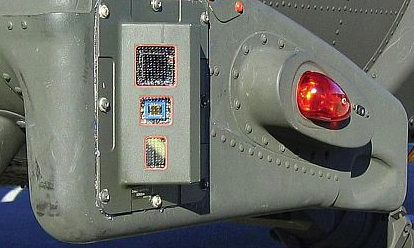
One of the four sensor packages to detect laser threats on U.S. military helicopters
From Avionics Intelligence August 31 2013 and September 3 2013
Saudi Arabia: UPDATED - 14 young patients injured by high-powered handheld lasers
According to HealthNewsDigest.com, “All injuries occurred during play and involved teenage boys and young males, between the ages of 11 and 30. Some injuries were accidental, but others involved a playmate intentionally pointing the laser beam at the victim's eye. The distance between the victim's eye and the laser beam ranged from 1.7 feet to 20 feet (a half-meter to 6 meters). Those who suffered retinal holes were injured at the closest distance, around half meter, or 1.7 feet. Generally, injury from greater distance resulted in less serious damage, the authors of the report say.”
The report was presented August 24 2013 during a Toronto meeting of the American Society of Retina Specialists by Fernando Arevalo, M.D. He is professor of ophthalmology at the Wilmer Eye Institute, Johns Hopkins School of Medicine, in Baltimore Maryland and is also affiliated with the Saudi hospital. Dr. Arevalo hopes that his findings, which were provided to the Minister of Health, will result in changes to how Saudi Arabia regulates handheld lasers.
Click to read more...
US: FDA asks Customs' help on illegal imports of laser pointers
Using Form 2877, the importer must submit information on each shipment and must affirm that the products comply (or do not comply) with FDA laser regulatory standards. But if a small package omits Form 2877 and is mislabeled (not using the word “laser”), this is an attempt to evade FDA and Customs. FDA specifically notes that such single-package Section 321-type imports do not meet the FDA’s criteria for enforcement discretion for personal importation.
Lasers that FDA is interested in include laser pointers, laser gun sights, laser levels, laser light shows, laser pointer key chains, veterinary laser products, laser illuminators and similar products. If a shipment does not meet FDA requirements, it can then be detained by the FDA and would not be allowed into the country.
From STR Trade Report. Thanks to New Aje Lasers for bringing this to our attention.
Belgium: Art installation uses laser pointers to trigger visuals, play music in a church
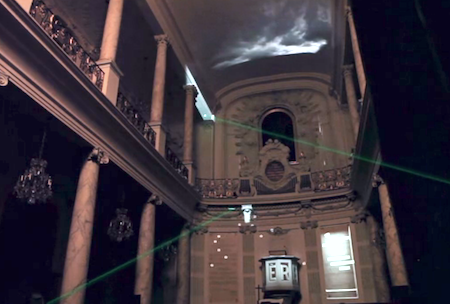
The laser pointer coming from lower left leaves a trail of falling “stars,” while the laser coming from the right triggers a glow on a ceiling beam plus a video to play on the ceiling.
The installation, Archifon II, was created by artists Tomáš Dvorák and Dan Gregor.
From Archifon, which has an embedded video of the installation shown above, Archifon II, as well as the first Archifon.
US: UPDATED - New Jersey to ban laser pointer sales above 1 mW
The bill was first submitted in November 2010, in response to ongoing problems in Ocean City, N.J. and other beach resort towns where widespread laser pointer sales in boardwalk shops were leading to harassment incidents and aircraft illuminations.
As passed, the bill states that “No person shall sell or offer to sell a laser pointer that exceeds one milliwatt in output power.” A pointer is further defined as “any device that emits laser light to project a beam that may be used for aiming, targeting or pointing out features.”
The penalty is a civil fine of up to $500 for the first offense, and up to $1000 for each subsequent offense. There are two exemptions: for laser pointers intended to be affixed to a firearm, and for a laser pointer used by or under the supervision of a N.J. licensed healthcare practitioner.
If signed in August 2013 by Gov. Christie, it would take effect December 1 2013.
From CBS New York and New Jersey 101.5. The bill’s legislative history and text is available on the New Jersey Legislature website; use the “Bill Search” feature to search the 2012-2013 legislative session for the keyword “laser”.
UPDATED - October 17 2013: The bill was vetoed on October 17 by Governor Christie. In a statement, he noted that the bill would have gone “well beyond” the federal government’s 5 milliwatt limit for laser pointers. He said there was no criminal use of lasers between 1 and 5 mW in New Jersey. Christie indicated the bill was “arbitrary” and interfered with lawful commerce of pointers typically used in business presentations. The full text of Christie’s veto message is here.
Related LaserPointerSafety.com news stories about Ocean City and New Jersey laser troubles
- August 26 2010: Ocean City officials discuss city-wide ban on laser pointers after summer incidents.
- November 22 2010: State senate bill 2430 is introduced in November 2010 to ban laser pointers above 1 milliwatt.
- June 8 2011: Man buys laser in Ocean City, points it at helicopter, and is almost immediately arrested.
- June 11 2011: Residents report harassment; voluntary sales ban is not working.
- June 24 2011: Unanimous vote on the initial measure to ban Ocean City laser pointer sales and possession.
- July 14 2011: Unanimous vote on the “second reading” to make the Ocean City ban official.
- April 16 2013: North Wildwood NJ bans sale and possession of laser pointers above 1 mW.
- August 20 2013: New Jersey state legislature passes bill to ban laser pointer sales above 1 mW; sends bill to Governor for signature.
- October 17 2013: Governor Chris Christie vetoes bill to ban laser pointer sales, saying the 1 mW power limit was “arbitrary” and there was no criminal use of lasers between 1 mW and the federal limit of 5 mW in New Jersey.
Switzerland: Police want higher power laser pointers classed as weapons
Since 2011, laser pointers above 5 milliwatts are prohibited in Switzerland. The Swiss Federal Office of Public Health is working on proposals to classify laser pointers as weapons and will present these by 2014.
From 20 Minuten (original German text and Google-translated into English)
US: Army Research Laboratory works on laser protection for eyes, sensors, etc.
Laser protection team leader Andy Mott was quoted as saying “Lasers of varying pulse width and wavelength are being developed every day. We protect against the known threats, and unknown ones. We develop protection for electronic sensors of the future, as well as the sighting systems of today.”
More details are at the Military.com story
US: Amazon.com tightens rules for laser pointer sales
The new Amazon.com policy requires pre-approval of laser pointers and related products. The products are limited to Class 3R (5 mW) or less and must be branded; examples include Kensington, Quartet, 3M and Logitech. Products must have a testing report from Intertek, UL or SGS.
It is not known if this is a U.S.-only policy or if it extends to other non-U.S. Amazon sites.
Click to read more...
US: Think Geek introduces toy shark with frickin' laser on its head
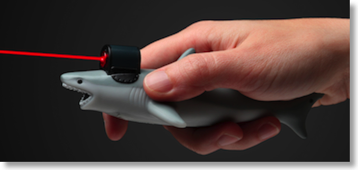
The gadget references the Austin Powers spy spoof movies. In 1997’s International Man of Mystery, the character Dr. Evil asks for “frickin’ sharks with frickin’ laser beams attached to their heads.” In 2002’s Goldmember, his son Scott actually develops the sharks:
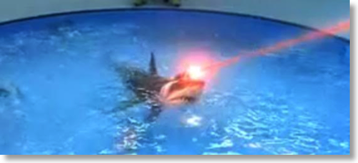
From Think Geek by way of Gizmodo. See also our May 2012 story about a laser pointer attached to a (real) shark’s fin, done for publicity purposes.
US: FDA warns parents of dangers of laser toys; issues draft guidance
In an August 6 2013 press release and Consumer Health Information article, FDA warned parents that lasers operated unsafely can cause serious eye injuries and even blindness. FDA said injuries from lasers can go unnoticed for days or weeks since there is no pain. But vision can slowly deteriorate over time, eventually causing permanent eye damage.
FDA gave the following as examples of children’s toy laser products:
- Lasers mounted on toy guns that can be used for “aiming”;
- Spinning tops that project laser beams while they spin;
- Hand held lasers used during play as “light sabers”;
- Dancing laser beams projected from a stationary column; and
- Lasers intended for entertainment that create optical effects in an open room.
Interestingly, the FDA’s press release and article gave tips on safe usage, including not aiming at car drivers or sports players -- but did not say that it is unsafe and illegal to aim at aircraft.
On August 7 2013, FDA issued draft guidance for industry on minimizing the risk of lasers in children’s toys. Comments are invited within 90 days of the Federal Register publication of the guidance, or by November 4 2013. The draft guidance is reprinted below.
Click to read more...
US: UPDATED - Laser pointer restrictions have made a "huge" positive difference in Myrtle Beach
He said that lasers last year, in 2012, were a “fad”. Visitors to the city purchased them from vendors as an impulse purchase
Horry County, which also passed a similar law, has seen similar results. “So far this year, there has been a large decrease in calls concerning the usage of green lasers and zero citations have been issued,” said Lt. Robert Kegler of the Horry County Police.
In the summer of 2012, there were 70 reports of lasers being aimed at aircraft near Myrtle Beach International Airport. The equivalent number for 2013 is not known.
Both ordinances state that adults improperly using lasers will be charged with assault and battery; the penalty is a fine of up to $500 and up to 30 days in jail. They will also be held liable for any damage or personal injury. Minors improperly using lasers will be prosecuted in Family Court, and their parents can be held responsible with a fine of up to $500 and up to 30 days in jail.
From Myrtle Beach Online and CarolinaLive.com
UPDATED September 3 2013: A letter from Coast Guard officials had some additional information: “Notable progress has been made, evident through a recent spring break sting operation that found no businesses selling lasers along the beachfront. There were a of [sic] total 68 laser incidents reported to the FAA in 2012 in the greater Myrtle Beach area. So far in 2013, the Coast Guard has not had any of its aircraft illuminated by lasers in the area. We applaud the efforts made by local leaders and sincerely appreciate the community’s support of the initiative.” The August 30 2013 letter was signed by Capt. Ric Rodriguez, Commander, Coast Guard Sector Charleston and by Commander Gregory Fuller, Commanding Officer, Coast Guard Air Station Savannah. From Myrtle Beach Online
US: FDA proposes amending Federal laser manufacturer regulations
The proposal was issued in the Federal Register on June 24 2013. The public may send comments to FDA until September 23 2013. FDA will then evaluate the comments, make any changes as a result, and at a future date will put the amendments into effect.
For consumer lasers, the most significant proposal is to create a new category of specific purpose lasers, “children’s toy laser products.” FDA says these could include lasers intended for creating entertaining optical effects, dancing laser beams projected from a stationary column, spinning tops which project laser beams, or lasers mounted on toy guns for “aiming.” FDA defines such toys as “a product that is manufactured, designed, intended or promoted for use by children under 14 years of age.”
The laser inside such a toy would be restricted to Class I (less than 1 mW for visible light). This is because FDA is concerned that if the toy were broken or disassembled, a higher power laser could harm a child.
Click to read more...
Sweden: Ban/restrictions proposed on laser pointers 1 mW or more
Some countries such as Australia and the U.K. have restrictions on lasers starting at 1 mW (3R, 3B and 4), while others such as the U.S. have restrictions starting at 5 mW (3B and 4 only).
The Swedish government invites comments on the proposal, EU notification text, number 2013/0365/S-X00M. This can be done up until October 4 2013 by anyone, whether a national of Sweden or not. At the EU notification link, there are additional links to obtain language-specific versions of the proposal; for example, the English draft text of the proposed laser pointer ban.
Comments can be sent to the EU Contact point Directive 98/34 at:
or send a fax to +32 229 98043. Also, Martin Lindgren of the Swedish Radiation Safety Authority has requested a copy so he is aware of the comments as well:
Additional details are below.
Click to read more...
Egypt: First-person account detailing laser use during Cairo protests
A new, first-person account from Egypt states that laser pointers were originally used to harass snipers and lookouts using binoculars, and to irritate political enemies. However, the dramatic use of dozens of lasers aimed at Egyptian army helicopters was intended as friendly, being used to “greet” the military who by this time was on the side of the protesters.
(It needs to be noted that, regardless of intent, laser light can flashblind and disrupt pilots. Due to the potential flight and crash hazards, it is illegal in the U.S. and many countries to even aim a laser towards an aircraft.)
Click to read more...
Germany: Hobbyist creates laser "Gatling gun" with six rotating 1.4 W blue beams
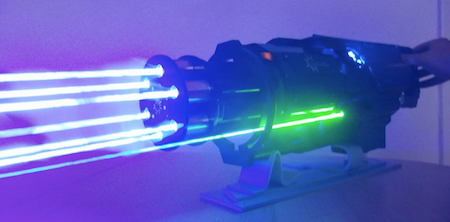
UK: More than 220 laser attacks in two years in West Midlands, says CAA
This is roughly one-third of the 700 incidents over the same time frame that involved aircraft in or above the West Midlands. (The 480 non-laser incidents included bird strikes, emergency landings, a bomb threat, a dog on the runways and closure of an airfield because of a flying kite.)
On one occasion in July 2011, four different lasers were aimed at a police helicopter in a single incident.
The British Airline Pilots’ Association asked for prison sentences for persons caught aiming at aircraft, as well as regulations over the sale of high-powered lasers.”
According to West Midlands police, laser attacks on their helicopter have fallen in months prior to July 2013.
From the Birmingham Mail. See also a related LaserPointerSafety.com article on BALPA’s laser pointer suggestions.
Egypt: Dramatic photo of lasers on helicopter was Photoshopped

The bright rays and the lens flare effects were not captured by the camera but were added later. This may have been done for artistic effect, or to make the lasers look more dangerous. However, this incident does serve as a reminder that “you can’t always believe what you see”.
Egypt: UPDATED - Dozens of laser pointers used in protests to simultaneously paint helicopters
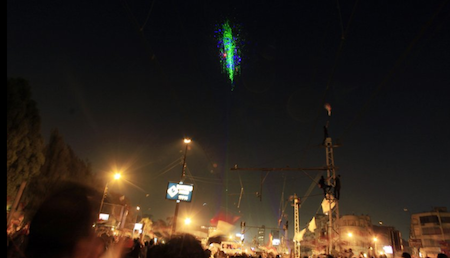
An aerial view, as seen on Egyptian network Capital Broadcasting Center, gives an idea of what the lasers looked like approaching Tahrir Square. In this scene, there is one blue beam and roughly 30 green beams.
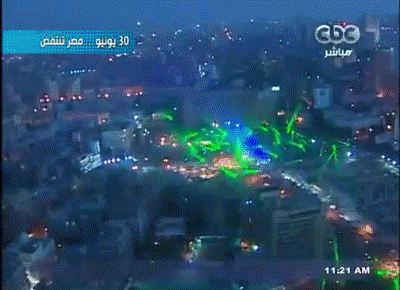
Animated GIF via “Cyparagon”. The original video can be viewed here (the aerial laser segment starts about halfway into this video).
There have been no reports of injuries to the air crews, or of the laser light causing the pilots to lose control. [UPDATE, July 8 2013: A first-person account states that the pointers were friendly, intended to “greet” the army pilots who at this point were on the side of the protesters.]
New Zealand: Average of 8.9 laser injury claims per year, costing NZD $93.63 each
The laser injury claim rate has increased from about 5 per year to about 13 per year, over the 2000-to-2013 period. The increase works out to 0.73 additional claim per year. This increase is one reason that New Zealand is taking action in 2013 to restrict higher-power handheld lasers.
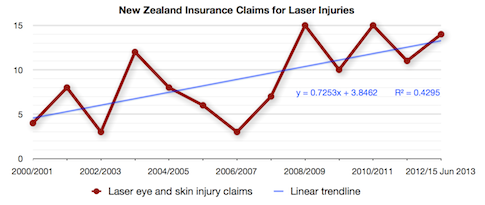
UK: Pilots want jail for persons aiming laser pens at aircraft
BALPA general secretary Jim McAuslan asked for a government cross-agency summit to address the problem. BALPA requested stronger regulations restricting the sale of high-powered lasers, more prosecutions, and action taken through trading standards.
He said that hotspots include airports at Manchester, Glasgow, Liverpool and Heathrow.
From ITV London and ITV Granada
Canada: Iridian announces new anti-laser protection glasses
The LaseReflect Aviator LRG10 glasses are said to mitigate the effects of laser illumination incidents. They reflect more than 99% of 532 nanometer green laser light, the most common color in laser attacks. (According to FAA statistics, about 95% of reported incidents in recent years have involved green light.) They also reflect near-infrared light at 1064 nm, which often is a byproduct of green lasers that are not manufactured with adequate IR-blocking filters. The cost is USD $299.
Custom LaseReflect Aviator glasses are available for specific colors and powers, including multiple wavelengths in a single pair of glasses. For example, blue (405 nm and 445 nm) and red (650 nm) light can also be reflected by the glasses.
Click to read more...
World: Discussion of how lasers damage imaging sensors
This is being posted because some persons may find the ideas presented to be useful. An additional resource is a page at the International Laser Display Association, about damage to cameras at laser light shows.
From Image Sensors World
US: Laser/aircraft incidents have increased compared to 2012
In 2012 and previous years, FAA was able to release detailed weekly reports tracking the number, type, and other data about laser incidents. But due to budget considerations in 2013, FAA has not yet been able to disseminate any reports. Thus, there is some uncertainty in the 1,500 approximation.
Based on this uncertainty, LaserPointerSafety.com has calculated that there could be between 1% and 16% more laser incidents in 2013 than in 2012. If accurate, any increase would represent a setback from the 2012 totals, which were 3% lower than in 2011. Having a rise in incidents would indicate that the publicity and prosecutions which form the majority of current U.S. anti-laser efforts are not having the desired effect.
The 2013 estimate of 3,774 incidents is based on comparing FAA reports from Jan. 1 to June 12 2013 to the same time period in 2012, and then extrapolating the 8.4% increase over the entire year. However, FAA changed their reporting procedures in 2013 so it is unclear how much of the estimated increase, if any, is an actual increase and how much is due to the new reporting procedures.
For the last comprehensive FAA figures, see our page Latest 2012 laser/aircraft incident statistics.
UPDATE, August 16 2013: New information shows 2,200 incidents from January 1 through August 2 2013. This is an 18% increase over the same period in 2012. Also, it does appear that FAA’s 2013 incident reports are comparable to 2012’s -- they have not yet significantly changed their reporting procedures or criteria. More information is at this LaserPointerSafety.com story.
US: Researchers illuminate retinas to help stop laser damage
Because the laser pulse wavelength used was in the infrared, and the cells were cultured (not live retinas) there is no current practical use for pilots and others looking for glasses-free resistance to visible laser light. However, this research may open up other avenues as it does indicate that perhaps the retina can be “hardened.”
Click to read more...
US: UPDATED - Video of homemade 3 watt handheld laser gains attention
Lasers in the 1 watt range have been widely available since the mid-2010 introduction of the Wicked Laser Spyder III Arctic blue laser. This is the first handheld 3 watt laser that LaserPointerSafety.com has been aware of.
Click to read more...
US: New Maryland law criminalizes aiming laser pointers at aircraft
Click to read more...
New Zealand: UPDATED - Gov't to restrict handheld laser pointers
The new law will not cover low-power lasers below 1 milliwatt which are used for presentations, surveying or gun sights. It will control importation, and will restrict use of higher-power handhelds to “authorized users who have a legitimate purpose such as astronomers, researchers and the NZ Defence Force”, according to an Associate Health Minister.
Click to read more...
US: FAA study compares fixed-wing airplane laser incidents with helicopter incidents
The study found that helicopters were 3.4 times as likely to be illuminated at altitudes below 2,000 feet than fixed-wing aircraft. Helicopter aircrews were twice as likely to report adverse effects such as distraction, vision interference, operational problems, and pain.
The study also broke down adverse effects by the type of flight, such as commercial, law enforcement, medical and military.
One conclusion of the study is that the “results may also justify the expense of equipping rotary-wing aircraft (particularly law enforcement aircraft) with laser detection and tracking devices to improve the possibility of apprehending perpetrators of these offenses.”
A detailed summary is at LaserPointerSafety.com’s 2013 FAA helicopter study webpage. The full 6-page report is available online from the FAA.
US: South Carolina to ban laser pointer possession by minors
The bill was introduced by Representative Liston Barfield. He represents Myrtle Beach and North Myrtle Beach, resort towns which have been plagued with incidents of laser pointer harassment by youths and others. In 2012, there were more than 70 area incidents where laser pointers were aimed at aircraft, including Coast Guard search-and-rescue operations that were abandoned due to fear of laser exposure.
Click to read more...
US: North Wildwood NJ to ban laser pointer sales and possession
This was done after about 40 complaints to police in 2012, most of which "turned out to be kids playing with the laser pointers" according to the deputy police chief. The U.S. Federal Aviation Authority had also contacted the city regarding lasers pointed at aircraft. The ordinance language notes that "the illegal use of laser pointers creates risks and dangers for those targeted by the beam of the laser as well as for the residents of and visitors to the city of North Wildwood.”
Ordinance 1622 had its "first reading" on April 16, meaning it did not become law. The second reading, and possible adoption as a law, was set for the City Council meeting the evening of May 7 2013.
Click to read more...
US: L.A. Sheriff's Dept. puts "Laser Strike" info video on YouTube
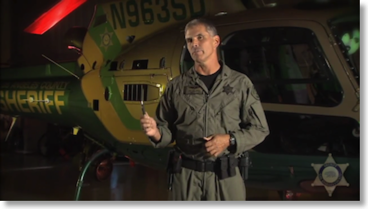
To see the video, click this link to YouTube. Following this link should also lead to the bonus content videos.
To get a flavor of the training video, click the “Read More…” link below for a list of selected excerpts and interesting statements.
Scotland: Pilots want stepped-up prosecution against laser attacks
An April 2013 investigation by the Scottish Express found 338 incidents in Scotland from January 1 2011 through February 13 2013. Only 12, or 3.5 percent, had been solved. The paper noted that the International Air Transport Authority (IATA) suggests there are 12 incidents involving lasers each day globally. [Note: The U.S. rate is approximately 9-10 per day, indicating the rest of the world’s rate is 2-3 per day which LaserPointerSafety.com believes to be higher.] An IATA spokesperson said the organization “support[s] strong penalties for anyone caught engaging in the act.”
The U.K.’s Civil Aviation Authority said there were 152 laser incidents at Heathrow Airport in 2012, compared with 136 incidents at Glascow Airport which has 1/10 the number of passengers.
The Scottish Express story contains additional statistics on Scotland airport lasing rates.
From the Scottish Express
US: TSA agent mistakes pepper spray for laser pointer
From the New York Post
World: Summary of papers presented at International Laser Safety Conference 2013
Laser pointer hazards for pilots
- A study of the actual output of 40 laser pointers, with powers up to 1.5 Watts, showed significant differences between measured and calculated hazard levels. In some cases, the actual hazard measured at some spots inside the beam was three times the estimated hazard. This is due to the laser output not being smooth in all cases, but instead the beams having “hot spots”. The study also showed that windscreens reduced the beam irradiance -- which is safer for pilots -- from 5% to 60%. (Note however that the McLin study described below showed that windscreens also spread the beam and thus increase glare.)
- A discussion of how being inside the Nominal Ocular Hazard Distance of a laser beam does NOT mean instant blindness for pilots and others.For example, consider a 1 Watt, 1 milliradian laser where the recommended safety distance (NOHD) is 733 feet. If possible, you should be at least 733 feet from the laser before exposing an eye to the direct beam. What is the actual hazard? At 232 feet from this laser, there is a 50/50 chance of the beam causing a barely observable retinal lesion under laboratory conditions where the laser and eye are fixed in place. Due to motion of the aircraft and hand-holding the laser, the chance of a retinal lesion is likely to be less. The distance from 232 feet (“ED50”) out to the NOHD at 733 feet is a known “safety factor” where the chance of retinal injury decreases even further. At the NOHD there is a “vanishingly small risk of hazardous exposure” (Sliney, 2013). Police and other first responder pilots can use this information to better weigh the risk of laser exposure to laser light vs. the benefits of completing a mission (rescuing a person, apprehending criminals, etc.). This presentation also discusses ways to make flight near lasers safer for pilots. A PDF file of all the slides presented is here.
For additional ILSC 2013 papers, click the “read more” link.
Click to read more...
UK: Seizure of 7,000+ laser pointers illustrates control problems
7,378 lasers were seized, along with 8,780 parts from which lasers could be assembled. It was estimated that the company sold over 35,000 laser pointers from 2009-2011, generating income of over £1,000,000 (USD $1,600,000).
Techyun Hii, 33, pleaded guilty to four charges of laser pointer violations and a fifth charge of unsafe power chargers. He was sentenced to a 180 day jail term suspended for 18 months, and to 300 hours of community service. The lasers were later incinerated in a hospital’s furnace.
Lead author John O’Hagan detailed the HPA’s findings in a paper presented at the March 2013 International Laser Safety Conference in Orlando. The case had previously been reported by LaserPointerSafety.com.
Click to read more...
UK: Low-cost laser event recorder is an iPhone app
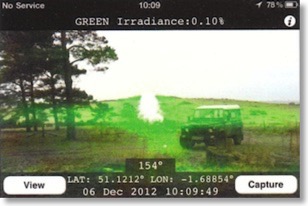
US: Government agency finds most laser pointers they purchased are overpowered
The findings were made public at a March 20 2013 meeting of the International Laser Safety Conference.
Researcher Joshua Hadler designed the measurement device to be accurate, inexpensive and easy-to-use. It would cost roughly $2000 in equipment costs to make a copy of the NIST device; plans are available from NIST for interested parties.
From a NIST press release, March 20 2013.
Click here for the full press release:Click to read more...
Australia: Ban on laser pointers has been a "detriment" to safety
The author, Trevor Wheatley, is chair of the Standards Australia SF-019 Committee on laser safety. He studied 41 lasers purchased online in 2012 that were claimed by the sellers to be legal -- lower than the Australian import limit of 1 milliwatt. Most cost less than AUS $20.
Wheatley found that 95% of these pointers were illegal under Australian law, with outputs above 1 mW. Of the 41, 78% were between 5 mW and 100 mW. (5 mW is generally taken to be the highest safe power for a general purpose laser pointer.)
Based on Wheatley's research, "...there would appear to be a greater than 50% chance that someone attempting to buy a 'safe' laser pointer would inadvertently get a hazardous laser." Further, 100% of the tested laser pointers below $20 "would represent prohibited weapons in most Australian states."
From other statistics, the paper states that "availability has not been significantly impacted." In 2007/2008 there were 648 incidents involving lasers pointed at aircraft. In 2010/2011, well after the import and possession restrictions, the number of incidents had increased to 828.
Click to read more...
US: Gold-coated nanotech could "laser-proof" pilots' glasses
According to a professor at Embry-Riddle Aeronautical University, gold-tinted eyewear has been used by military pilots for laser protection but only works against certain wavelengths of laser light. However, said Dan Macchiarella, if Thomas’ idea “could be applied to lasers of all strengths and wavelengths, that would certainly be a big advancement.”
A March 10 2013 Orlando Sentinel story noted that funding cuts and competition for grants mean that Thomas’ research faces “some serious hurdles” to develop this idea further. Thomas said finding research money is “going to be very difficult, very difficult.”
From the Orlando Sentinel
US: Retina specialist says laser pointer crackdown needed to avoid serious injury
The Yahoo Sports story noted that laser pens are often misused by European soccer fans. In late February 2013, two world-famous players, Cristiano Ronaldo and Lionel Messi, were targeted during a pair of games.

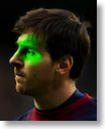
Ronaldo (left) and Messi, illuminated by lasers during matches between Real Madrid and Barcelona
Josephburg told Yahoo Sports that athletes could be especially at risk, since lasers could cause serious damage from an exposure of a few seconds. He said “If I was a ball player I would be terrified. I only hope that Congress acts on this before some real harm is done.”
Lasers with powers of over 50 milliwatts are dangerous, Josephburg said, and can have serious effects almost immediately. The only effective deterrent is to punish possession or use of high-powered pointers, according to Josephburg: “There is simply no need for a regular person to have one of these.”
From Yahoo Sports
US: North Myrtle Beach bans sale of lasers over 1 mW, and bans possession by minors in detailed new law
Click to read more...
US: FAA updates laser reporting method in AC 70-2A
The changes include:
- Air Traffic Control can now regard a laser illumination of aircraft incident as an “in-flight emergency”, due to the potential debilitating injuries which could compromise safety and interfere with aircrew duties.
- New web-based methods by which pilots can report incidents
- Additional information in the Resources and the Related Documents sections
The key part of the document is the reporting procedure: “On arrival at destination, all aircrews that have been affected by an unauthorized laser illumination are requested to complete the Laser Beam Exposure Questionnaire. The questionnaire is located on the FAA’s Laser Safety Initiative Web site at http://www.faa.gov/about/initiatives/lasers/ and can be electronically submitted. The questionnaire may also be printed and faxed to the WOCC at (202) 267-5289, ATTN: DEN, or emailed to laserreports@faa.gov.”
From FAA Advisory Circular 70-2A
US: FAA updates pilot reporting questionnaire
Flight information
- Aircraft type: Airplane, rotorcraft, lighter than air, other
- Type of operation: Commercial aviation, general aviation, military, law enforcement, medical, news reporting, other
- Time of day: Daytime, around sunset, dusk/twilight, nighttime before midnight local time, nighttime on or after midnight local time, around sunrise, dawn/morning twilight
- Phase of flight: Taxi, takeoff, climb to altitude, cruise altitude, descent, final approach, landing, low-altitude, hover, other
Effect on flight
- Did the laser interfere with crew duties? Yes (describe), no
- Did the laser cause a change in flight path? No, minor/non-adverse change, major/adverse change
- Did the laser disrupt a law enforcement, medical or military mission? Yes (describe), no
Illumination details
- Did the laser appear to track the aircraft? Yes, no, other
- Did the laser illuminate any part of the cockpit? Yes, no, other
- Did the laser shine directly into one or both of your eyes? Did not shine directly, shined a little, shined brightly
Effect on illuminated pilots or crew
- Choose from a list of vision effects: None, glare, temporary flashblindness or afterimages, blind spot(s), blurry vision, significant loss of night vision, other
- Choose from a list of physical effects: None, watering eyes, eye discomfort/pain, headache, shock, disorientation or dizziness, other
- Did you rub your eye after exposure: No, a little, vigorously
If there was an eye exam
- Type of doctor who did the most comprehensive exam: Retinal specialist, ophthalmologist, optometrist, optician, emergency room doctor/nurse, other
- List results of the exam
Prior laser knowledge
- Did you have any prior knowledge or training? None, basic info, detailed specific info on how to “recognize and recover”, simulator training with laser or laser-like exposure, other
From FAA Laser Beam Exposure Questionnaire
US: 2012 laser/aircraft incident statistics
What is an FAA-reported “laser incident”?: This is defined as an aircraft pilot seeing one or more laser beams during flight. A mid-2011 study by Rockwell Laser Industries of 6,903 incidents reported to the U.S. Federal Aviation Administration found that in 27% of incidents, beams entered the cockpit (passed through the windscreen). For example, in 2011, there were 3,591 incidents of which approximately 970 (27%) involved beams in the cockpit.
Year-to-Date Comparison
The 3,482 reported U.S. laser/aircraft incidents in 2012 compare with 3,591 incidents during 2011, approximately 2,836 incidents during 2010, and approximately 1,527 incidents during 2009.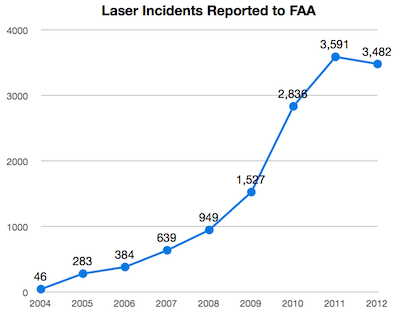
The number of U.S. laser incidents decreased slightly in 2012
Projected 2013 Estimate
If the number of laser/aircraft incidents in 2013 continues to decrease at the same rate as from 2011 to 2012 (-3.04%), then there would be 3,376 incidents in 2013.
Adverse Effects
In 36 (1.0%) of the 3,482 laser/aircraft incidents in 2012, a pilot or aircraft occupant reported a temporary adverse visual effect such as flashblindness, afterimage, blurry vision, eye irritation and/or headache. In four of the 36 eye incidents, the eye effect may have been more serious or long-lasting. In no incidents, either in 2012 or in previous years, was there any permanent eye damage.Total Incidents, 2004 to Date
There have been approximately 13,737 laser/aircraft incidents reported to FAA, from January 1 2004 through December 31 2012..
Click to read more...